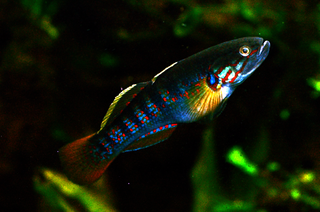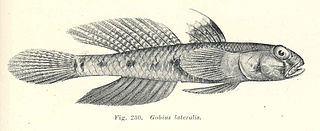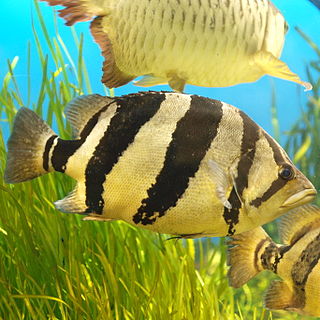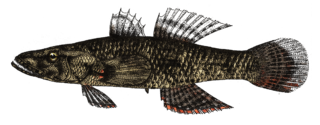
The Percidae are a family of ray-finned fish, part of the order Perciformes, which are found in fresh and brackish waters of the Northern Hemisphere. The majority are Nearctic, but there are also Palearctic species. The family contains more than 200 species in 11 genera. The perches, and their relatives are in this family; well-known species include the walleye, sauger, ruffe, and three species of perch. However, small fish known as darters are also a part of this family.
The Marmara barbel is a species of cyprinid fish endemic to Turkey where it is only known from fast flowing waters with substrates of stones or pebbles. This species can reach a length of 35 centimetres (14 in) SL.

The Carangidae are a family of ray-finned fish which includes the jacks, pompanos, jack mackerels, runners, and scads. It is the largest of the six families included within the order Carangiformes. Some authorities classify it as the only family within that order but molecular and anatomical studies indicate that there is a close relationship between this family and the five former Perciform families which make up the Carangiformes.

Eleotridae is a family of fish commonly known as sleeper gobies, with about 34 genera and 180 species. Most species are found in the tropical Indo-Pacific region, but there are also species in subtropical and temperate regions, warmer parts of the Americas and near the Atlantic coast in Africa. While many eleotrids pass through a planktonic stage in the sea and some spend their entire lives in the sea; as adults, the majority live in freshwater streams and brackish water. One of its genera, Caecieleotris, is troglobitic. They are especially important as predators in the freshwater stream ecosystems on oceanic islands such as New Zealand and Hawaii that otherwise lack the predatory fish families typical of nearby continents, such as catfish. Anatomically, they are similar to the gobies (Gobiidae), though unlike the majority of gobies, they do not have a pelvic sucker.

Barbonymus is a ray-finned fish genus in the family Cyprinidae, containing some barb species. The genus was only established in 1999, with the tinfoil barb as type species; thus, these fish are sometimes collectively called tinfoils. The new genus was established in recognition of the fact that some large Asian "barbs", formerly rather indiscriminately lumped in Barbus, Barbodes and Puntius, form a distinct evolutionary lineage.

Favonigobius is a genus of gobies native to fresh, brackish and marine waters around the Indian Ocean and the western Pacific Ocean. Commonly called "sand gobies", this term more alternatively refers to the family Kraemeriidae, a relative of the true gobies.

Sardinella is a genus of fish in the family Clupeidae found in the Atlantic, Indian and Pacific Ocean. They are abundant in warmer waters of the tropical and subtropical oceans. Adults are generally coastal, schooling, marine fish but juveniles are often found in lagoons and estuaries. These species are distinguished by their ranges and by specific body features, but they are often confused with one another. Fish of the genus have seven to 14 striped markings along the scales of the top of the head. The paddle-shaped supramaxilla bones are characteristic; they separate Sardinella from other genera and their shapes help distinguish species. They have paired predorsal scales and enlarged fin rays.

Ambassis is a genus of fish in the family Ambassidae, the Asiatic glassfishes. They are found widely in the Indo-Pacific region, with species in fresh, brackish and coastal marine waters.
Awaous is a genus of fish in the family Gobiidae, the gobies. They are native to fresh, marine and brackish waters from Africa to the Americas.

Butis is a genus of fishes in the family Butidae found in fresh, brackish, and marine waters from the Indian Ocean coast of Africa through Southeast Asia to the Pacific islands and Australia.

Stenogobius is a genus of fish in the goby subfamily, Gobionellinae. They are native to fresh, brackish and marine waters along the coasts of the Indian and Pacific Oceans. They are known commonly as coastal stream gobies.

Lutjanidae, or snappers. are a family of perciform fish, mainly marine, but with some members inhabiting estuaries, feeding in fresh water. The family includes about 113 species. Some are important food fish. One of the best known is the red snapper.

Cynoglossus is a genus of fish in the family Cynoglossidae. Most species are indigenous to the Indo-Pacific region, but there are also a few in warmer parts of the East Atlantic. They are commonly found in shallow waters on a muddy or sandy bottom, including estuaries and a few species are restricted to fresh water. One species Cynoglossus sinusarabici has invaded the Mediterranean Sea through the Suez Canal from the Red Sea, a process known as Lessepsian or Erythrean migration.

Ilisha is a genus of ray-finned fishes in the family Pristigasteridae. The genus contains 16 species. It is similar to Pellona but lacks a toothed hypo-maxilla. The genus has a worldwide distribution in tropical and subtropical coastal waters and estuaries. Some species also enter rivers, and I. amazonica and I. novacula are largely–if not entirely–restricted to tropical rivers.

Datnioides is a genus of fish known commonly as tigerfish, tiger perch or freshwater tripletails. It is the only genus in the family Datnioididae. These fish are found in fresh and brackish waters of rivers, estuaries and coastal areas in South and Southeast Asia, and New Guinea.

Nemapteryx is a genus of sea catfishes found mostly in coastal marine and brackish waters from South Asia to Australia with one species occurring exclusively in fresh waters of the Fly River in Papua New Guinea. There are currently six recognized species in this genus.
Pao is a genus of mostly freshwater pufferfish with one species also occurring in brackish water. They are found in Southeast Asia. Until 2013, its species were generally placed in Tetraodon.

Pseudogobius is a genus of fish in the goby family, Gobiidae. It is widely distributed in tropical and temperate regions of the Indian and western Pacific Oceans. Species occur in freshwater and estuarine habitat types, such as mangroves and seagrass beds.

Dichotomyctere is a genus of relatively small pufferfish found in both fresh and brackish waters in south and southeast Asia. Its species were generally included in the genus Tetraodon until 2013. The largest species of Dichotomyctere reach up to 17 cm (6.7 in) in length.

Butidae is a family of sleeper gobies in the order Gobiiformes. The family was formerly classified as a subfamily of the Eleotridae but the 5th Edition of Fishes of the World classifies it as a family in its own right. Molecular phylogenetic analyses have demonstrated that the Butidae are a sister clade to the clade containing the families Gobiidae and Gobionellidae and that the Eleotridae is a sister to both of these clades. This means that the Eloetridae as formerly classified was paraphyletic and that its subfamilies should be raised to the status of families.

















